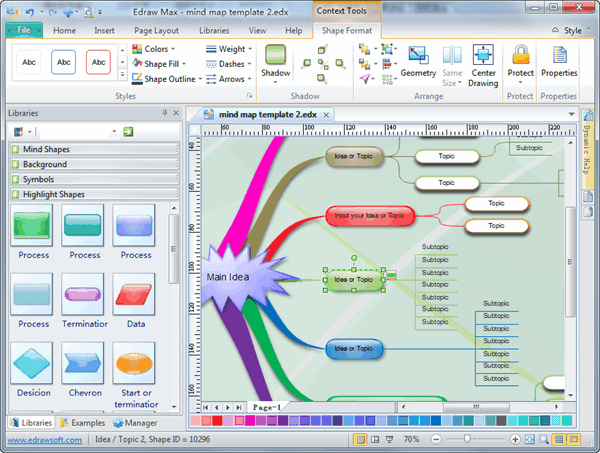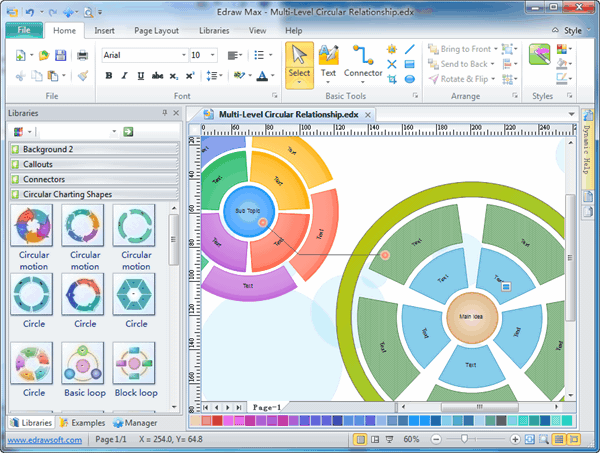Brainstorm Diagram Programming
Advertisement A good resume template for Microsoft Word can help you get a job. But did you know that there are several other types of templates for Microsoft Word that can help you get any job done? For instance, let’s take a pressing problem that has you stumped right now. Microsoft Word can help you attack the dilemma with a good old-fashioned Two heads think better than one, but brainstorming is as much about individual problem solving as it is about the group. Here are some methods to build up a “storm” of ideas. Yes, whether you are alone or with a discussion group, use the hairsplitting power of mind maps and brainstorms to break any mental impasse.
Allow us to scrounge the Microsoft Gallery for the best templates that will help you put your heads (or just a lone head) together to unravel a problem or an idea. Except there is one small problem The Official Brainstorming Templates Have Vanished Microsoft Word didn’t want you to doodle aimlessly on a scrap of paper. The Office.com template gallery offered a few brainstorming and mind mapping templates that helped you grease your mental rivets. But then Microsoft Office went and overhauled the old gallery when it launched as an alternative to Google Drive. With a Microsoft account, you can now use the free Office Web Apps and the templates for free. But the catch? The new has got rid of the old.
Many of the useful templates you may have used for brainstorming are no longer available. Search with a keyword like “Event Map” or “Story Map”.
Jul 10, 2009. Up vote 1 down vote. I like writing on whiteboards. Great for db diagrams, task lists, feature lists, (other lists,) random ideas, notes, etc. (db diagrams being the biggie for me).
The new Office.com gallery has thousands of new stylish templates but not the ones for your brainstorms. You might get a whiff of a template for Visio, PowerPoint, or Excel.
But not much for Word. Browse the too. With a search keyword like “mindmap”, I got an Idea Planner for Word but not something that is more visual for clearly interlinking my thoughts. But as we know the web is a vast place.
There are Rather than creating a new document from scratch, you'll want to start with a template that you can customize. Find free professional templates on one of these sites. So, let’s fire up Microsoft Word because we have done the searching for you. Many useful templates are still available on other sites. Here are 8 free templates that can help you generate ideas with Microsoft Word. These templates are meant to be easy. Their basic design serves two purposes.
The simple design makes them flexible and you can easily modify them yourself in Microsoft Word. The templates forgo flashy design and instead force your focus on the structure of your thoughts instead of the presentation. Story Map Templates The Story Map template is suitable for writers who are trying to outline a plot. It can also be used by students to plan a narrative.

In a business scenario, you can plan a team role-play exercise and connect a solution to the underlying problem by assigning specific roles to team members. Education World has an array of simple story map templates for teachers and students. The Story Map Organizer in the download source below can help you create an arc with the setting, main characters, supporting characters, problem, and solution. Download from: Also. Process Chart A business process can get complex. A process flow chart is a decision-making tool which helps you visualize the outcome if you favor one decision over another. A process flowchart is the best tool to plot the movement of any complicated decision whether it may relate to programming or hiring an employee for your business.
This Microsoft Word template is a simple step-by-step process chart that takes you through a hiring process but it can be re-purposed to clarify the flow of any process. You can use the process chart to break down a complex event into a sequence of smaller action steps. Download from: 3.
Event Map Remember the old poem that went like this – “I keep six honest serving-men (They taught me all I knew)”? This poem is the thumb rule of used by everyone, from police investigators to storytellers. You can use this Event Map template to break down the idea or problem into the five W’s and one H. Trying to write your first story or blog post? Use this to develop your outline. I found this erstwhile Microsoft Word template on a non-Microsoft source. You can use this to break an event down to its core nuts and bolts and understand it from different angles.
Download from: 4. Spider Map A simple Spider Map (or a spidergram) is a little like a conventional mind map with its radial arrangement.

The large central circle represents your main idea, and the branching linear lines can be used to jot down the subsidiary ones. You can use the spider map to investigate various aspects of a single topic or just to organize their thoughts about a subject. There are some key differences between spider maps and mind maps go back to their origins. Spider maps traditionally do not use color or images and make more use of phrases or sentences. But the goal for both remains the same – place many ideas in relation to the central concept and visualize your thinking.
Download from: 5. Umbrella Chart To be frank, I haven’t figured out a way to use this MS Word template effectively yet, so I have yet to find out if it is more versatile than a pie chart. The theory says that you can arrange the details of any subject or topic in the pie-shaped areas. The core idea goes into the central circle and then you fill up the “umbrella” with subordinate ideas around the spokes. This free umbrella chart zip file I found looks plain, but it can be a good launch pad for students and teachers.
You can make umbrella charts spectacular with color as you will see when you search for or for PowerPoint. Download from: 6. KWL Chart With this simple columnar template, you can easily track what someone (or you) knows (K), wants to know (W), and has learned (L) about a subject. It’s a very handy aid for and also if you are trying to research something.
A well-structured KWL template can be used to fill up the gaps in prior knowledge if you focus on the W (wants to know). As a student, you can avoid repetition and concentrate on what you want to learn. Then, you can plan how and where to learn it from. Teachers can use print this Word template and use it to follow a student’s progress. Download from: (Portrait and Landscape Modes) 7. T-Chart Every issue has two sides and this template helps you to examine both sides of the same coin.
Anything that can be broken down into two opposing views can be stated using the T-chart. The T-chart is a graphic organizer that can be used to look at different viewpoints and broaden your view on an issue. Select two ideas to compare. List the topics as headings for the columns below. Then compare the two by writing statements in the corresponding columns.
But do note that a T-Chart need not always be a two-column table. The resource link below gives you a variety of T-Chart templates to use in a quick brainstorming session. Download from: 8. Rafter revit crack. Fishbone Diagram The Fishbone diagram came out of Japan (not surprisingly).
Also called, they are somewhat advanced idea organizers in comparison to the others we have on this list. The skeleton of the wish can help to pin down the relationship between a cause and its effect. You can use it to drill into the root cause of a problem by organizing a complex cause-effect event into categories.
The Fishbone diagram is widely used in quality control. But you can use it take your thinking out of a rut. As you can see above, the fish bones are plotted to illustrate cause and effect. The head of the fish occupies the problem you are trying to solve. Brainstorm all the possible causes of the problem and give them one branch each from the spinal column of the fish. The larger bones near the head of your fish are the most important causes followed by the less important ones towards the tail. Download from: Make Your Own Templates in Microsoft Word Why not make your own versions of these templates that wrap around your specific needs?
All you need is simple Microsoft Word skills. I showed you Templates are vital time-saving devices you can use for almost any situation in life. When the special situation comes, can you make your own template?
Brainstorm Diagram In Visio
We show you how. Microsoft Word has most of these tools too. These free templates are mere tools. Your brainstorming effectiveness will depend on how well you gather your ideas before you put them on paper or on the screen. Use these downloadable files and turn them into idea organizers in a flash anytime you want.
Just customize the templates by changing the text labels and/or adding to the sections. Are you a brainstorming kind of guy? Tell us how you go about it and tell us especially if Microsoft Word is on your list of tools.
What do you think of these simple and free templates?
Kaoru Ishikawa, a Japanese expert, is credited with inventing the fishbone diagram to help employees avoid solutions that merely address the symptoms of a much larger problem. A fishbone diagram is useful in brainstorming sessions to focus conversation.
After the group has brainstormed all the possible causes for a problem, the facilitator helps the group to rate the potential causes according to their level of importance and diagram a hierarchy. The design of the diagram looks much like a skeleton of a fish. Fishbone diagrams are typically worked right to left, with each large 'bone' of the fish branching out to include smaller bones containing more detail.
Fishbone diagrams are used in the 'analyze' phase of SixSigma's (define, measure, analyze, improve, control) approach to problem solving. How to create a fish diagram:. Create a head, which lists the problem or issue to be studied.

How To Make Brainstorm Diagram
Create a backbone for the fish (straight line which leads to the head). Identify at least four “causes” that contribute to the problem. Connect these four causes with arrows to the spine. These will create the first bones of the fish. Brainstorm around each “cause” to document those things that contributed to the cause. Use the or another questioning process such as the 4P’s (Policies, Procedures, People and Plant) to keep the conversation focused.
Continue breaking down each cause until the root causes have been identified. This example illustrates how a group might begin a fish diagram to identify all the possible reasons a web site went down in order to discover the root cause.